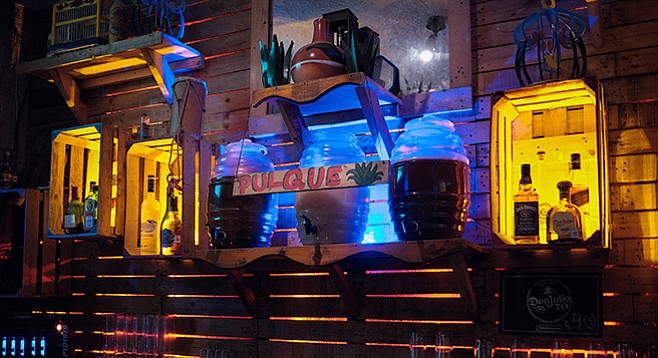 Facebook
Facebook
 X
X
 Instagram
Instagram
 TikTok
TikTok
 Youtube
Youtube

Long before Tecate roja and caguamas of Indio dominated Mexican bartops, Aztec priests, warriors, and sacrificial victims sipped a milky agave wine called pulque. Fabled among its acolytes as a wellspring of fertility and divine inspiration, pulque is now available at a small handful of bars in Tijuana and even fewer in San Diego.
Last time I checked, Ranas Mexico City Cuisine in Spring Valley and Aqui es Texcoco in Chula Vista still sourced their pulque from a can. Try it and see what you think about human sacrifice. Even fresh pulque is an acquired taste, to put it politely. The first sip generally hits like a mouthful of vomit. The second is just acrid. By the third swill, if you’ve stuck it out this far, you may detect the oatmeal or celery juice that serves as flavoring. If you’re into it at this point, great. Hold onto your butt and wait for Quetzalcoatl’s wings to sprout from your back as the ascorbic elixir works it magic.
“They say it’s the drink of the gods,” bartender Francisco tells me one quiet evening at Zenzontle Bar, located within Tijuana’s popular craft taproom village, Plaza Fiesta. Oaxacan art and clay tile flooring pose a homely contrast to the electronic music pulsing from neighboring clubs as Francisco pours samples of today’s tonics: coconut, tamarind, and vino tinto (red wine). “It can be as strong as 10 percent down south, but what I like is that it tells the story of Mexican culture. My family is from Chiapas, where you can still eat tamales de iguana with your pulque. It’s an ancient part of Mexican culture.”
Zenzontle sources their aguamiel, or agave sap wine, from Ensenada-grown maguey, the same plant that gives us tequila and mezcal. They mix the aguamiel with a variety of fruits and ferment it only briefly to achieve a smoother product that is friendlier to newcomers at around 2 to 4 percent alcohol. This is necessary in Tijuana, Francisco says, because many northerners are unfamiliar with the 2000-year-old beverage. The result is considerably less offensive than the pulque in bars you’ll find packed with university students down in Mexico City.
Feeling macho? Order your pulque “valiente” for an extra 50 pesos ($2.50) to get a shot of tequila in the mix. Zenzontle’s sister spot, Mezcaleria Trajinera, offers a variety of tequilas and mezcals straight up or in cocktails for about $4 each.
Paseo de los Heroes 10001, Plaza Fiesta, Tijuana
Directions: Uber to Plaza Fiesta or walk about 20 minutes from the border
Prices: Pulque, 35 pesos (about $1.75); beer, 30–35 pesos; cocktails, 80 pesos
Hours: Vary, but generally open afternoons and evenings
Food: Pizza, nachos, carne seca, and chapulines (crickets)
Capacity: Sits 15 inside, 25 outside
The Deal: TWO FOR ONE pulque curado (flavored) on Tuesdays


Long before Tecate roja and caguamas of Indio dominated Mexican bartops, Aztec priests, warriors, and sacrificial victims sipped a milky agave wine called pulque. Fabled among its acolytes as a wellspring of fertility and divine inspiration, pulque is now available at a small handful of bars in Tijuana and even fewer in San Diego.
Last time I checked, Ranas Mexico City Cuisine in Spring Valley and Aqui es Texcoco in Chula Vista still sourced their pulque from a can. Try it and see what you think about human sacrifice. Even fresh pulque is an acquired taste, to put it politely. The first sip generally hits like a mouthful of vomit. The second is just acrid. By the third swill, if you’ve stuck it out this far, you may detect the oatmeal or celery juice that serves as flavoring. If you’re into it at this point, great. Hold onto your butt and wait for Quetzalcoatl’s wings to sprout from your back as the ascorbic elixir works it magic.
“They say it’s the drink of the gods,” bartender Francisco tells me one quiet evening at Zenzontle Bar, located within Tijuana’s popular craft taproom village, Plaza Fiesta. Oaxacan art and clay tile flooring pose a homely contrast to the electronic music pulsing from neighboring clubs as Francisco pours samples of today’s tonics: coconut, tamarind, and vino tinto (red wine). “It can be as strong as 10 percent down south, but what I like is that it tells the story of Mexican culture. My family is from Chiapas, where you can still eat tamales de iguana with your pulque. It’s an ancient part of Mexican culture.”
Zenzontle sources their aguamiel, or agave sap wine, from Ensenada-grown maguey, the same plant that gives us tequila and mezcal. They mix the aguamiel with a variety of fruits and ferment it only briefly to achieve a smoother product that is friendlier to newcomers at around 2 to 4 percent alcohol. This is necessary in Tijuana, Francisco says, because many northerners are unfamiliar with the 2000-year-old beverage. The result is considerably less offensive than the pulque in bars you’ll find packed with university students down in Mexico City.
Feeling macho? Order your pulque “valiente” for an extra 50 pesos ($2.50) to get a shot of tequila in the mix. Zenzontle’s sister spot, Mezcaleria Trajinera, offers a variety of tequilas and mezcals straight up or in cocktails for about $4 each.
Paseo de los Heroes 10001, Plaza Fiesta, Tijuana
Directions: Uber to Plaza Fiesta or walk about 20 minutes from the border
Prices: Pulque, 35 pesos (about $1.75); beer, 30–35 pesos; cocktails, 80 pesos
Hours: Vary, but generally open afternoons and evenings
Food: Pizza, nachos, carne seca, and chapulines (crickets)
Capacity: Sits 15 inside, 25 outside
The Deal: TWO FOR ONE pulque curado (flavored) on Tuesdays
Comments